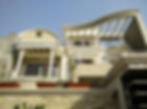
Stone Arts
Garden Ornaments and cast stone Building Materials for Build,
Restoration, Garden, Landscape, Memorial, Fireplace
+254 718 849 241 - info@stoneartskenya.com
+254 737 849 241 - pankaj@stoneartskenya.com
Online Catalogue
General Facade & Lobby Works / Projects
SURVEY AND TYPICAL DEFECTS
The first stage in any programme of work to a facade is a
survey to determine the type and extent of defects, as well as
suitable repair methods and materials. The most useful
diagnostic tool is close range visual inspection and hands-on
assessment of visible defects, from a hydraulic access
platform or, ideally, from access scaffolding.
There are more sophisticated non-destructive techniques,
such as impulse radar and thermography, for the detection of
problems such as embedded iron cramps, voids and the depth
of facing stones, but actual acoustic sounding by hand using
tools will identify hollowness and detachment, for example
where fractures or spalls (in stone or mortar repairs) are
visible and there may be a risk of stone falling. It is important
to have tools at hand during survey, including chisels of
suitable size for joints, to check the soundness of original
mortar and later repointing, and a heavier tool (chisel or other)
for acoustic sounding of surfaces: literally for tapping to check
whether detachment is audible.
REPAIR TECHNIQUES AND MATERIALS
Historic indent (stone) repair carried out during construction:
as in this Victorian example, these repairs were typically of
high quality and followed the informal contours of the
damaged area. Indents must be properly specified and used;
they typically need to be dowelled in place but on projections
and exposures dovetailing is also advisable. Repair methods
which should be anticipated for a Portland stone facade that
has been poorly repaired or neglected in the past will include:
-
cleaning
-
repointing of joints (of varying widths)
-
grouting joints and fractures
-
deep tamping of severely eroded joints
-
pinning through fractured elements
-
removal of redundant fixings and corroding embedded iron cramps which have caused spalling on the face
-
indent repairs for large losses, areas of decay or damage
-
and mortar repairs for small scale losses and areas of damage, such as fixing holes.
To achieve a durable and visually acceptable mortar repair, a number of parameters must be specified and followed:
-
preparation of existing stone
-
reinforcement
-
mortar mix (binder and aggregate types)
-
protection and curing.
When defects are so extensive that the integrity of the block as a whole and its ability to function and shed rainwater is compromised, or where the number of repairs required to restore integrity would be unreasonable, replacement is the best option. This condition may entail overall surface weathering and erosion or a combination of various defects, such as fractures, spalls and erosion. In most cases it is pointless to ‘reface’ a complete stone in this condition with mortar. Unfortunately, such repairs are commonly found on historic buildings, often in severe exposures and without adequate reinforcement, and need to be removed.
CLEANING
Cleaning, and each type of stone repair, should always be subject to trial to determine the best methods and to set parameters. Provided that heavy black soiling deposits have not developed, which is unusual now in Africa, Portland stone typically responds well to water cleaning. In the past, flood cleaning using large quantities of water was normal. In current practice, water delivered from fine sprays provides sufficient water to dissolve and mobilise the soiling that develops in urban areas. Some brown staining (thought to be mobilised from within the stone by water) is likely to emerge after cleaning, as the stone dries out. This normally occurs in areas of past water penetration, such as around open joints and fractures, on projections, or where staining was visible before cleaning. Plain clay poultice will typically reduce this brown staining, which also recedes with exposure to sunlight.
Where soiling or staining is not water soluble it may be necessary to resort to chemical cleaning agents or poultices. For example, oil staining and metallic staining from iron or copper will not respond to water cleaning. Various proprietary products are available for treatment of these and other types of staining. It is normally best to trial chemical cleaners in unobtrusive areas as they can be overly effective and the contrast between clean and untreated areas can be stark. For water soluble staining the plain clay poultice is gentler and avoids this problem of contrast.
SCULPTURES
Sculptures should be treated as distinct elements from the masonry and may require specialist conservation treatment. Some principles apply to both masonry and sculpture: the need to prevent water traps as far as possible and cleaning to reveal detail and facilitate future survey work. However, sculpture is more vulnerable to damage, particularly in the context of cleaning. It may be necessary to provide temporary protection to prevent accidental impact damage in the course of work. Initial survey should identify the need for any special cleaning materials or techniques, as well as vulnerable areas which might need treatment, for example mortar repairs to protect or prolong the life of detail.




